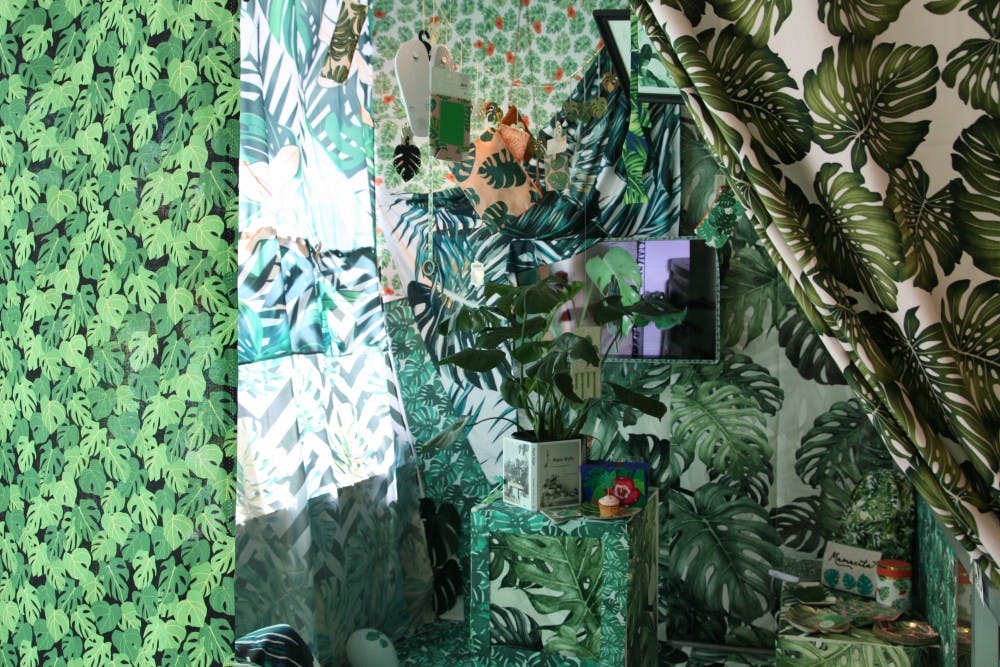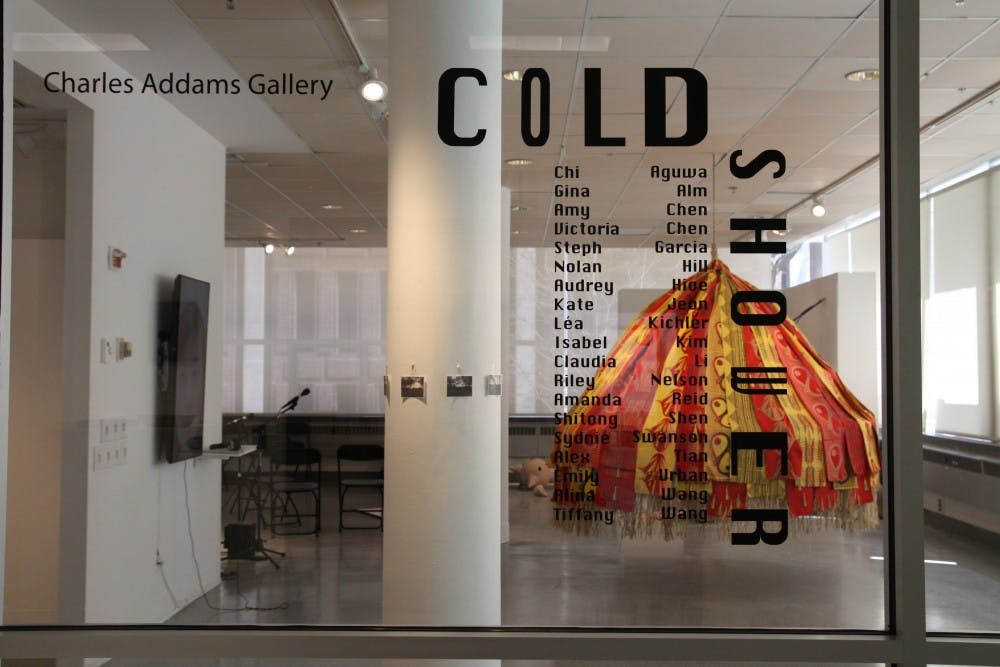It is the last Monday night of the semester. In the quiet darkness of the Charles Addams Gallery, a student sits on the floor next to two instructors, looking at her painting hanging on the wall. “I might remove this,” she wonders aloud, “I don’t think it is having the conversations I want it to have.”
The crowd that had squeezed into the Gallery for critiques on the senior fine arts thesis show, Cold Shower, has long left. The silent figures of a suspended crêpe paper house, a TV screen, cloths and three microphones—objects from other art projects in the exhibition—stand watch like sentinels behind her. She debates with her instructors, and they talk about everything—from aesthetics to exhibition, to the commercialization of art. The probing of one rubs against the resistance of another. A lively discourse unfolds. The student considers everything she could have done more, done different, done anew in her art.
This incessant questioning and restless curiosity form the heartbeat of the fine arts program.
Art is not just a “release,” Kayla Romberger, a lecturer in the Fine Arts Department who oversaw the Senior Fine Arts Seminar this semester, shares, “we challenge our students in a way that is really rigorous.” Paraphrasing one of her favorite quips from Fine Arts Chair Ken Lum, Romberger muses that art can serve as a way to question why certain things exist in the world, "either through the work or through the very expression of such curiosities."

This semester’s exhibition grapples with family histories, digital consumption, identities and surveillance, among other things. Fabrics of worn clothes and family photographs stitched together hang in one corner, while broken pieces of glass stand on a small shelf to the side. “A wholeness made of edges,” the artist proudly declares in her statement. A peephole is etched in one wall. A screen lies beyond it, showing a loop of animation. The act of voyeurism is made public here. “Much like the endless social media scroll, the voyeur decides when they will turn away from the surplus of private information, and what they will retain from it,” declares another statement.
The show is a culmination of a year’s worth of brainstorming, hard work and critiques for graduating fine arts majors. Under the guidance of Romberger as well as drawing/painting instructor, Ivanco Talevski, students not only work on their own projects, but come together to organize the exhibition. They are given assignments as early as July of their penultimate summer, and spend the academic year attending classes on current artistic practices and theory, developing their projects in the studio and preparing for the exhibition.
Graduate instructors outside the course drop in to give feedback. The class regularly overran its 3–hour slot, extending to 4.5 hours every week. As Talevski puts it, “it’s almost like packing a whole undergraduate BFA course into one year. “But the students do it!” he exclaims proudly, "they rise to the occasion." He finds great joy in watching students grow over the course of their work, developing their ideas and craft deeper.
Gina Alm (C’18), who is majoring in both Fine Arts and Economics, shares that the hours are intense as the class always overruns, but is quick to point out that “everyone is there because they love it.” Gina came to Penn to run track and initially had no particular major in mind. She took her first fine arts course in digital design in freshman year, but it was a photography class in sophomore year that cemented her desire to major in Fine Arts. While her Econ major provides its own "usefulness and practicality," the Fine Arts program has helped her to "grow intellectually and find a rich community,” where she has met people whose goals are “quite different from the goals of the university as a whole.” Her art at the exhibition deals with absurdity, erasure and what may not be immediately perceptible to the viewer.
When Isabel Kim (C’18) first matriculated at Penn, she was determined to avoid art, as she had always been known as “the art and writing kid” in high school. However, her desire to create won out by the end of sophomore year and she soon declared the Fine Arts major. Her senior thesis is informed by an experience of being “Internet popular” in the blogosphere, where she received 500 semi–anonymous questions in her inbox and has 2500 followers on her blog. She calls her art project in the exhibition a “self-portrait" that grapples with digital intimacy and perceptions on the Internet.
Isabel has plans to go to law school while Gina will spend some time after graduation to make a “hopefully collected, informed decision” about her next steps. While not every graduating senior chooses to pursue a job related to art, Talevski remarks that the experience in fine arts is valuable as it consistently pushes students to “think outside preconceived frameworks” and fosters imagination. Talevski connects these skills to real-world applications that fine arts majors may encounter. In a world "rife with social and political problems," imagination will be indispensable in generating ideas, innovating solutions and empathizing with others.

